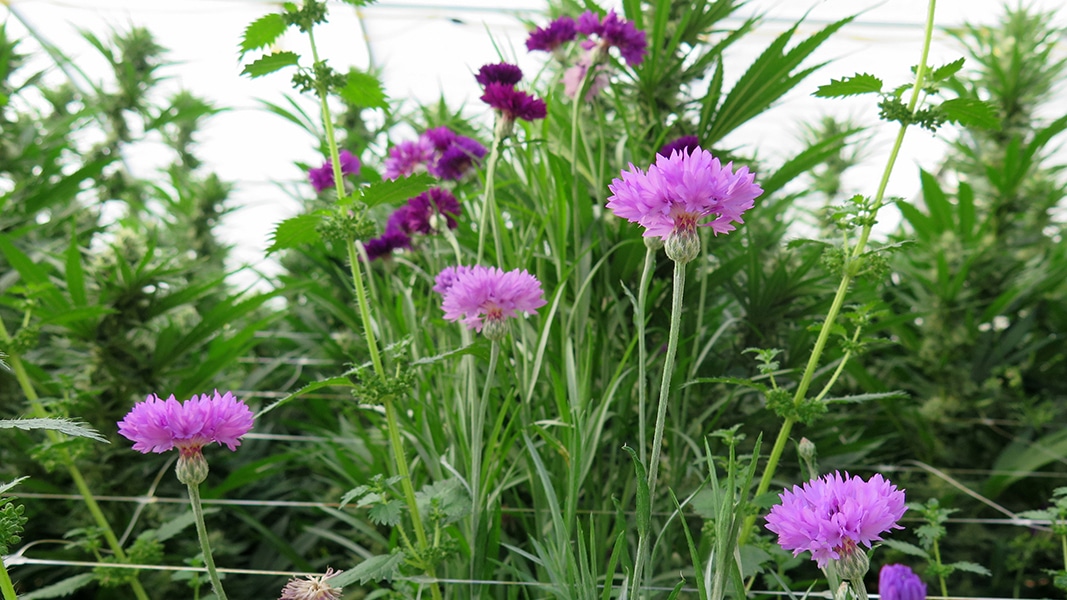We have a pesky, non-organic thorn in our side. Our current agricultural system is not based on sustainable means of cultivation and, unfortunately, this also applies to much of cannabis farming today. While the “organic” marijuana movement is gaining momentum, the vast majority of cultivators grow cannabis as a monocultural crop, which often entails the use of toxic pesticides and plant growth boosters to maximize profit.
A monoculture, or “monocropping,” involves growing one type of crop to the exclusion of others. There are virtually zero examples of monocropping in nature. Unlike monocropping, sustainable growing practices mimic what is done in nature and seek to recreate it in a controlled setting.
As interest in medical cannabis has increased, the terms “organic” and “sustainably grown” have become trendy buzzwords within the industry. There is obviously a need to propagate more cannabis to supply a large consumer demand, but the “more for your money” approach to growing has not been conducive to healthy stewardship of the land. Our corporate-dominated agricultural system is broken, and the cannabis industry should not emulate its worst features.
Some cannabis farmers have adopted sustainable, alternative practices, including a technique known as companion planting or “multicropping.” Companion planting is a method of cultivation where various plants are grown together in ways that promote a dynamic, flourishing ecosystem. Companion planting improves the land’s resilience and also increases the yield and health of the plants within the garden.
A Centuries-Old Practice
The science of intercropping cannabis is still in its infancy. Presently, there is little scientific study of companion planting in general, and research and development efforts in the area of cannabis cultivation face additional obstacles due to the plant’s historical stigma. But the absence of hard science doesn’t discredit the ancient cultivation methods that utilized permaculture techniques as the standard. Human beings were growing sustainably long before the advent of toxic, soil-depleting industrial agriculture.
A classic example of companion planting is the “Three Sisters Method” used by indigenous peoples in the Americas for food production. Various tribes planted beans, corn, and squash—the golden crop trio—in proximity. This practice reflects an understanding of plant mutualism, wherein each cultivar has one or more functions that benefit the botanicals growing around it. In the Three Sisters model, the beans act as a nitrogen-fixer, which is essential for plant growth; the corn feeds off the nitrogen; the beans use the corn to climb on; the squash provides a source of shade and natural mulch, which conserves moisture in the soil and aids the growth of beans and corn. The plants are engaged synergistically in positive ways, and this contributes to a dynamic, thriving agricultural environment.
The ancient practice of companion planting has been resurrected by modern-day permaculture farmers and to a lesser extent by cannabis growers. According to permaculturist Kate Miller of Alpine Botanicals in Nederland, Colorado, companion planting is “even more important now that we see what’s happening to the planet, to soil fertility or lack thereof, and to our pollinating insects. Pollinators such as honey bees, butterflies, bats, and other insects simply do not thrive in a monoculture.”
Miller’s medicinal garden includes cannabis and various companion plants with therapeutic properties of their own. Sometimes, these botanical companions can be combined with cannabis to create artisanal herbal formulas for healing.
Multiple Benefits
Miller says that comfrey offers significant benefits as a botanical companion, functioning simultaneously as a cover crop and dynamic accumulator. Comfrey is also a natural remedy for external wounds, rashes, repairing tissue, and other skin issues. “The only downside of growing comfrey,” Miller explains, “is that it can take over and its large leaves can also shade out other plants. This is not a bad thing if you’re trying to prevent weeds. You can chop up the comfrey leaves and use it as living mulch throughout the season, or even as animal fodder.”
Alfalfa is another example of a companion plant with therapeutic as well as other benefits. Alfalfa acts as a nitrogen-fixer and it also stabilizes terraces to prevent soil erosion. A cultivator can harvest alfalfa for making compost. Or it can be brewed and consumed as a mineral-rich medicinal tea.
Cameron, another Colorado-based cannabis cultivator, maintains that intercropping techniques enable his plants to reach their greatest potential. “As far as ganja farmers are concerned,” he asserts, “a high diversity of organic soil offers all the nutrients for the plant to bloom into its fullest expression. This enhances both the flavor profile and resin content.”
A well-fed plant is more likely to be disease-resistant. Permaculture techniques can build a plant’s resilience, making it stronger and healthier. Some cannabis cultivators utilize mycorrhizal fungus as a soil topping at the base of a marijuana plant to increase nutrient availability. “When all ecological niches are intentionally filled with beneficial organisms, there is little space for pests to take hold,” says Cameron.
Cannabis is a highly adaptable and durable plant, but diseases and pests pose ongoing risks in both indoor and outdoor cultivation. Monocultures are major targets for problematic insects and pathogens like powdery mildew. By diversifying their crop spectrum, farmers are less likely to lose plants to disease and insect infestation. Companion planting also helps to create a stable, diverse habitat for a myriad of birds, bees, and small animals, which interact in positive ways with their botanical counterparts.
Outdoors & Indoors
For outdoor grows, crop rotation can help an ecosystem flourish by diversifying the earthly terrain. It’s more difficult but not impossible to implement companion planting techniques when growing indoors. This can be accomplished by placing various companion plants—like basil to deter pests—around cannabis pots. Cover crops with shallow roots can also be placed at the base of a marijuana plant to promote nutrient availability in the soil. You can also get creative by planting aromatic herbs for cooking and for medicinal purposes when growing indoors.
“Throughout modern U.S. history, we have seen farmers falling victim to the monoculture cash crop mentality,” says Casey O’Neill, owner of Happyday Farms in Northern California. He grows 47 different kinds of veggies amongst his outdoor cannabis varieties. This enables Happyday to maximize space and harvest as much as possible from the same garden. O’Neill says that companion planting lowers cultivation costs and mitigates risk by providing economic protection that is lacking in monoculture farming. In the event of a theft or a raid, his food crops are left untouched and he is still able to sell vegetables at the local farmer’s market.
O’Neill says it’s important to be sensitive to the needs of one’s cannabis plants whether growing outdoors or indoors. “The plants want to be cared for and loved. I tend to think they like being around us,” he mused. “You can see a lot of sterile growing environments for cannabis. I don’t think that is appropriate for what the plant wants.”
Nakona, a Bay Area cannabis cultivator and artist of permanent ink at Blue Dragon Tattoo in San Francisco, also feels it’s important to tune into one’s plants and listen carefully to their language. Plants communicate in a variety of ways via aromatic terpenes that attract allies or repel predators as needed. “If you are talking to your plants, ask them what’s up. They will tell you what they need,” says Nakona, who grows cannabis and other botanicals both indoors and outdoors. He uses lavender for pest management and wild mustard to encourage beneficial pollinators. “The more bees around, the better,” he says. Nakona also integrates scarlet runner beans (for color, nitrogen fixing, and food) and nasturtium (as a cover crop, favorable bug attractor, and botanical remedy).
Tips for Companion Planting Beginners
What are some considerations for those who would like to start companion planting in their cannabis garden? “Companion planting can seem daunting if you don’t know which plants to use,” says Ryan Flint, a Mendocino county soil scientist and permaculturalist at Portal Plants. “Each kind of plant has specific growing conditions and needs.”
Understanding what a plant likes or dislikes and appreciating the unique qualities of each cultivar are crucial for intercropping. Flint uses various crops and permaculture techniques in his gardens, not always focusing on cannabis. A favorite cultivar is red amaranth, which he grows to fill in space in the garden. He also plants drought-tolerant vines such as morning glory, raspberry, and passion flower to create a natural screen from predators. Flint starts his cannabis seedlings using mycorrhizal fungi inoculation. He observed that mushroom beneficials dramatically enhance the health of cannabis and other plants. “Mycorrhizal fungi grow into the root cells of your plants and work symbiotically,” he explained. “They feed the plants water and micronutrients. In exchange, the plants then feed the fungi the extra sugars produced from photosynthesis.”
Not all plants do well together. As a general rule, a grower needs to avoid propagating crops in proximity to cannabis that are vulnerable to the same environmental threats like powdery mildew and russet mites. “Don’t plant things that would create susceptibility issues for cannabis,” advises Casey O’Neill from Happyday Farms. He avoids plants like cucumbers, melons, and squash, which are prone to powdery mildew. Instead, he recommends leafy greens for those who are beginning to intercrop their cannabis garden. Farmers should avoid growing plants with deep roots next to cannabis. Cultivars with shallow root structure, such as red clover, do not compete with cannabis for underground real estate.
Keep in mind that cannabis can also be a great comrade for other plants in your “regular” garden. Marijuana’s deep taproot is good for aerating soil and bringing nutrients closer to the surface. Including cannabis in a crop rotation may make nutrients more readily available for the crops that come afterwards.
Some Cannabis Companions
This list is available as a handout: Cannabis Companion Planting.
Companion plants fall into various categories. The list that follows is by no means exhaustive. Many plants fit into more than one group. Do your own research to see what works best for your specific growing conditions, purposes, and goals.
- Pest deterrents: These plants are generally aromatic in nature. They can confuse bugs or deter them all together by overwhelming them with a particular scent. Intersperse these with plants that are more susceptible to pests and predators. Lavender, lemon balm, catnip, basil, rosemary, sage, onion, garlic, peppermint, coriander, chrysanthemum, Artemisia spp. (wormwood & mugwort), dahlias, geranium, borage, calendula.
- Beneficial pollinator attractors: Crops that entice helpful insects and winged animal friends support a dynamic and flourishing ecosystem. Try to use native plants that are indigenous to your area as these critters will gravitate to varieties they are familiar with. An easy way to start a companion-oriented garden is to use a beneficial pollinator mix. Dill, yarrow, parsley, hyssop, lavender, cumin, calendula, lemon balm, anise, dill, catnip, goldenrod, alfalfa, parsnip, thyme, chrysanthemum, fennel, chamomile, stinging nettles, tansy, buckwheat, fennel, comfrey, sage.
- Camouflage: These plants entice your eyes. They look pretty and can take the pressure off of cannabis as the plant of focus. They can also prevent pests from getting to your cannabis, as insects also see these crops and gravitate towards them. Nasturtium, amaranth, wild mustard.
- Cover crops: Also known as “living mulch,” this type of plant typically grows close to the ground. It can be planted during off-season to minimize nutrient loss in the soil. Cover crops retain moisture and nutrients, thereby lessening the need for water consumption and commercial fertilizers. Cover crops can also be cut to ground level and allowed to compost in place, which prepares the soil for the next rotation. In addition, some of these plants can also be made into nutrient-rich compost teas, which aids in building an early resistance to powdery mildew. Nasturtium, comfrey, grains (oats & rye), red clover, peas, small edible greens, alfalfa, sweet peas, fava beans, vetch, stinging nettle.
- Nitrogen-fixers (dynamic accumulation): Following a heavy cannabis rotation, it’s good to grow restorative nitrogen-fixing plants (see below). These botanical friends have symbiotic bacteria in their roots, and they pull nitrogen from the atmosphere and transfer it into the soil in a way that benefits the surrounding plants. Nitrogen is essential for a plant’s growing cycle. It is a major component of chlorophyll, the compound that enables photosynthesis. Nitrogen is also an integral part of amino acids, which are the building blocks of proteins. Plants need proteins. Without them, they wither and die. Yarrow, hyssop, dandelion, vetch, comfrey, beans, peas, clovers, buckwheat, lentils.
- Micronutrient providers: These plants reinforce the ecosystem of beneficial organisms in the topsoil. Topsoil is where the majority of nutrients and beneficial organisms reside. Maintaining healthy topsoil enables diverse species to proliferate and provides your plants with a power boost. Dandelion, milk thistle, fungi.
- Medicinal plants: Many companion plants have unique healing properties. Plant lots of herbs. Grow your own medicine cabinet. Yarrow, hyssop, chamomile, calendula, comfrey, calendula, lemon balm, dandelion, milk thistle, anise, fennel, peppermint, coriander, borage, anise, goldenrod, alfalfa, thyme, chamomile, stinging nettle, tansy, sage, passionflower, parsnip, cumin, parsley, red clover, alfalfa, Wormwood, mugwort, borage, lavender, catnips, rosemary, chrysanthemum, geranium, dandelion, hyssop, dill, basil, raspberry…
- Food crops: Delicious vegetables, grains and legumes. Beans, wheat, rye, garlic, onion, peas, lentils, kale, collard greens, lettuces, salad mixes, bok choy, and many more.
© Copyright, Project CBD. May not be reprinted without permission.









